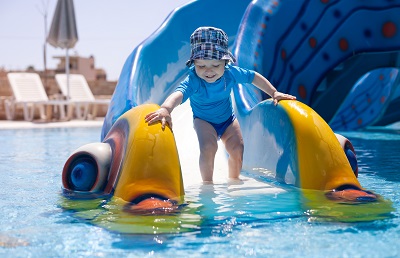10 Ways Water and Motion Play Boost Development
Many children love to splash in the water, run around, and climb. Some climb on the sofa or leap headfirst into the kiddie pool, and others have a meltdown the minute they touch water or their feet leave the ground.
Either one of these scenarios can be frustrating for a parent. If your child fears water or motion, it may seem easiest to avoid them. However, playing in the water or moving around actually boosts your child’s brain and body development, so helping them tolerate water and motion will assist their meeting important milestones.
This article aims to help you understand the reason your child should not avoid these types of play. Also included are ten ways motion and water play can boost your child’s development:
- Increase tolerance of motion and touching water – Youngsters are wired to feel, taste, and experience the world. While some do not have a healthy fear of danger, others are overly afraid. Both are typical and reflect personal preferences. However, children need to tolerate play activities such as a splash pad, dipping and pouring water from buckets, or running through the sprinkler with friends. Try going slow and easy as you introduce water and motion into your child’s play diet. Refrain from shaming.
- Increase overall strength – Climbing the ladder and sliding down the slide builds strength in the entire body. Balancing in the swing or kicking legs in the water increase strength and coordination. Children playing with other children is ideal as they learn and overcome fears together. A strong child is often a confident one.
- Learn words for different sensations – Talk through what your child is experiencing to build vocabulary. Such as, “Swinging is fun! Let’s swing on the tire swing” or “the water is cold and tickly, isn’t it?” Children need to associate words with their sensory experiences to enhance learning. For example, they will understand how dizzy feels, and this adds meaning.
- Learn words for different movements – Similar to #3 above. “Let’s dip this sponge in the water and then squeeze it out” or “Let’s slide down this big, yellow slide!” Children need to learn verbs, not just nouns.
- Learn words for different play items – “Climb up the slide” or “Run after the dog.” Again, narrating and labeling increase your baby’s vocabulary. You can also use descriptors, such as a high slide or brown dog.
- Increase coordination – Climbing on sofas, piles of backyard dirt or sand, and running through the yard sprinkler develop coordination and agility. Playing chase or follow the leader as they climb or run prepares them for more advanced motor skills, such as playing T-ball or riding bicycles with friends.
- Increase social and play skills – As your child gets older, more play activities will involve other children. For example, seesaws, swimming, and other activities require the ability to play together and communicate. To help your child learn to play with others, try tossing or kicking water balloons back and forth or bouncing on the trampoline together. Early opportunities will help your child better enjoy the company of others.
- Increase creativity and imagination – Our technology-infused world inhibits your child’s imagination. Free time allows their minds to create or imagine games and characters. Build time into the daily schedule for boredom to develop and give them time and encouragement to make their fun.
- Improve mood – Children need sensory experiences. Their little bodies seek them. Avoiding some sensory experience can block your child’s development in all areas. If water or motion scares your little one, slowly introduce them. Do not scold or shame them. Many children get fussy because they are bored or overstimulated by electronics. Get them outside digging, splashing in the kiddie pool, or swinging on the porch swing. Nature is the best playground and often improves mood.
- Improve appetite and sleep – Children need to move, explore, and burn off energy. So tired kiddos eat and sleep better.
In conclusion, play with your baby, so they see it is fun and safe. Maybe swing with your baby in your lap or slide down the slide the same way. Let them feel secure in your arms while experiencing scary sensations like rushing forward, being off the ground, or paddling in the pool. We each have feelings we enjoy or avoid. So, it’s okay if your child also has sensations they love or hate. The goal is safety and learning to at least tolerate scary feelings.
Find out if your baby’s milestones are on track. Get your FREE GUIDE here.
To keep up with the latest tips and ask questions, join us on Instagram at Grow with Ginny or listen on The New Mom Podcast.
(Photo: Adobe Stock)

